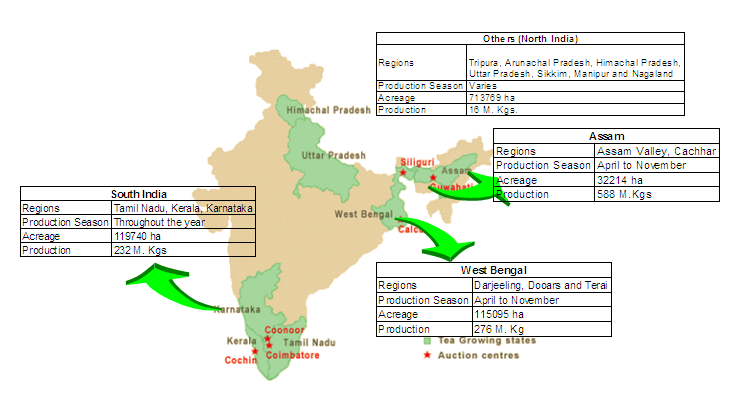Tea Board of India | 17 May 2024
Why in News?
Recently, a tea growers and manufacturers association reported that tea production in Assam and West Bengal may decrease by 50% in the coming months due to inadequate and uneven rainfall.
- Data from the Tea Board of India shows a projected 40% decrease in Assam and 23% decrease in West Bengal production until March 2024.
What is the Tea Board of India?
- About:
- The Tea Board India was established in 1903 through the Indian Tea Cess Bill, which imposed a tax on tea exports to fund the promotion of Indian tea domestically and internationally.
- The present Tea Board was set up under section 4 of the Tea Act 1953 and was constituted on 1st April 1954.
- It has succeeded the Central Tea Board and the Indian Tea Licencing Committee which functioned respectively under the Central Tea Board Act, 1949 and the Indian Tea Control Act, 1938 which were repealed.
- Organisation of the Board:
- The present Tea Board is functioning as a statutory body of the Central Government under the Ministry of Commerce.
- The Board is composed of 31 members (including the Chairman) drawn from Members of Parliament, tea producers, tea traders, tea brokers, consumers, and representatives of Governments from the principal tea-producing states, and trade unions.
- The Board is reconstituted every three years.
- Functions:
- Rendering financial and technical assistance for the cultivation, manufacture and marketing of tea.
- Aiding Research and Development activities for augmentation of tea production and improvement of tea quality.
- With Head Office located in Kolkata, West Bengal it has twenty-three offices which include Zonal, Regional and Sub-Regional Offices.
Key Facts About Tea:
- Growth Conditions:
- Climate: Tea is a tropical and sub-tropical plant and grows well in hot and humid climates.
- Temperature: The ideal temperature for its growth is 20°-30°C and temperatures above 35°C and below 10°C are harmful for the bush.
- Rainfall: It requires 150-300 cm annual rainfall which should be well distributed throughout the year.
- Soil: The most suitable soil for tea cultivation is slightly acidic soil (without calcium) with porous sub-soil which permits a free percolation of water.
- Tea is the second most consumed beverage in the world after water.
- India was the second-largest producer of tea after China, and the largest consumer of said beverage, using nearly 30% of the world’s tea output.
- Benefits:
- Antioxidants in tea help prevent oxidative damage to the body and act as reactive oxygen species (ROS) to repair damages caused by free radicals. They also enhance immune defense, lowering the risk of cancer and infection.
- Concerns:
- However, recent ICMR guidelines advise against excessive consumption of caffeine in tea and coffee as it can stimulate the body's central nervous system and lead to physiological dependence.
- The report stated that beverages like tea can bind dietary iron and make it unavailable, due to tannins in caffeinated beverages hindering iron absorption in the body.
- This can lead to iron deficiency and conditions like anaemia.
- However, recent ICMR guidelines advise against excessive consumption of caffeine in tea and coffee as it can stimulate the body's central nervous system and lead to physiological dependence.
UPSC Civil Services Examination, Previous Year Questions (PYQ)
Prelims
Q1. With reference to the "Tea Board" in India, consider the following statements: (2022)
- The Tea Board is a statutory body.
- It is a regulatory body attached to the Ministry of Agriculture and Farmers Welfare.
- The Tea Board's Head Office is situated in Bengaluru.
- The Board has overseas offices at Dubai and Moscow.
Which of the statements given above are correct?
(a) 1 and 3
(b) 2 and 4
(c) 3 and 4
(d) 1 and 4
Ans: (d)
Q2. Consider the following States: (2022)
- Andhra Pradesh
- Kerala
- Himachal Pradesh
- Tripura
How many of the above are generally known as tea-producing States?
(a) Only one State
(b) Only two States
(c) Only three States
(d) All four States
Ans: (c)
Mains
Q. Whereas the British planters had developed tea gardens all along the Shivaliks and Lesser Himalayas from Assam to Himachal Pradesh, in effect they did not succeed beyond the Darjeeling area. Explain. (2014)

